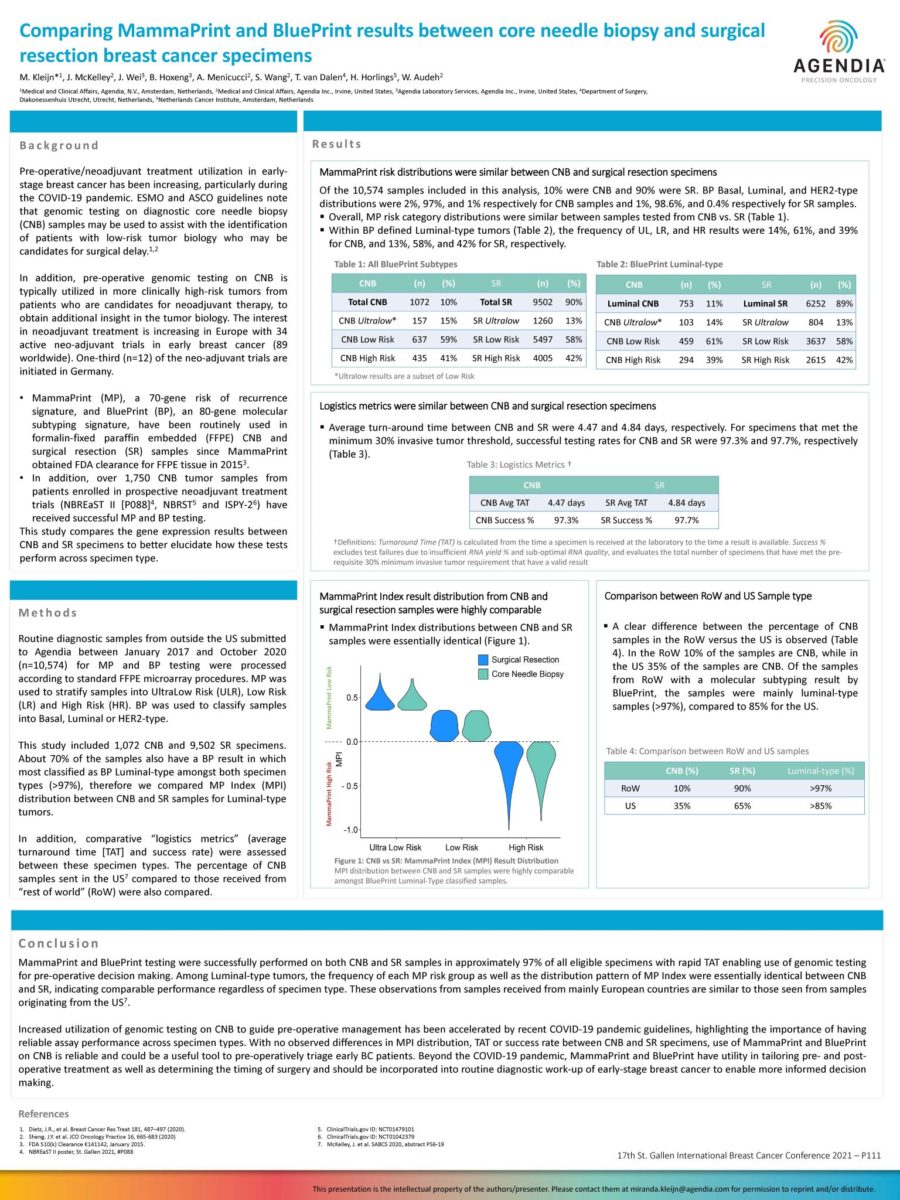Publication: St Gallen
Authors:
M. Kleijn, J. McKelley, J. Wei, B. Hoxeng, A. Menicucci, S. Wang, T. van Dalen, H. Horlings, W. Audeh
Background:
Pre-operative/neoadjuvant treatment utilization in early-stage breast cancer has been increasing, particularly during the COVID-19 pandemic. ESMO and ASCO guidelines note that genomic testing on diagnostic core needle biopsy (CNB) samples may be used to assist with the identification of patients with low-risk tumor biology who may be candidates for surgical delay.1,2
In addition, pre-operative genomic testing on CNB is typically utilized in more clinically high-risk tumors from patients who are candidates for neoadjuvant therapy, to obtain additional insight in the tumor biology. The interest in neoadjuvant treatment is increasing in Europe with 34 active neo-adjuvant trials in early breast cancer (89 worldwide). One-third (n=12) of the neo-adjuvant trials are initiated in Germany.
- MammaPrint (MP), a 70-gene risk of recurrence signature, and BluePrint (BP), an 80-gene molecular subtyping signature, have been routinely used in formalin-fixed paraffin embedded (FFPE) CNB and surgical resection (SR) samples since MammaPrint obtained FDA clearance for FFPE tissue in 20153.
- In addition, over 1,750 CNB tumor samples from patients enrolled in prospective neoadjuvant treatment trials (NBREaST II [P088]4, NBRST5 and ISPY-26) have received successful MP and BP testing.
This study compares the gene expression results between CNB and SR specimens to better elucidate how these tests perform across specimen type.
Results:
MammaPrint risk distributions were similar between CNB and surgical resection specimens
Of the 10,574 samples included in this analysis, 10% were CNB and 90% were SR. BP Basal, Luminal, and HER2-type distributions were 2%, 97%, and 1% respectively for CNB samples and 1%, 98.6%, and 0.4% respectively for SR samples.
- Overall, MP risk category distributions were similar between samples tested from CNB vs. SR (Table 1).
- Within BP defined Luminal-type tumors (Table 2), the frequency of UL, LR, and HR results were 14%, 61%, and 39%for CNB, and 13%, 58%, and 42% for SR, respectively.
Logistics metrics were similar between CNB and surgical resection specimens
- Average turn-around time between CNB and SR were 4.47 and 4.84 days, respectively. For specimens that met the minimum 30% invasive tumor threshold, successful testing rates for CNB and SR were 97.3% and 97.7%, respectively (Table 3).
Methods:
Routine diagnostic samples from outside the US submitted to Agendia between January 2017 and October 2020 (n=10,574) for MP and BP testing were processed according to standard FFPE microarray procedures. MP was used to stratify samples into UltraLow Risk (ULR), Low Risk (LR) and High Risk (HR). BP was used to classify samples into Basal, Luminal or HER2-type.
This study included 1,072 CNB and 9,502 SR specimens. About 70% of the samples also have a BP result in which most classified as BP Luminal-type amongst both specimen types (>97%), therefore we compared MP Index (MPI) distribution between CNB and SR samples for Luminal-type tumors.
In addition, comparative “logistics metrics” (average turnaround time [TAT] and success rate) were assessed between these specimen types. The percentage of CNB samples sent in the US7 compared to those received from “rest of world” (RoW) were also compared.
Conclusion:
MammaPrint and BluePrint testing were successfully performed on both CNB and SR samples in approximately 97% of all eligible specimens with rapid TAT enabling use of genomic testing for pre-operative decision making. Among Luminal-type tumors, the frequency of each MP risk group as well as the distribution pattern of MP Index were essentially identical between CNB and SR, indicating comparable performance regardless of specimen type. These observations from samples received from mainly European countries are similar to those seen from samples originating from the US7.
Increased utilization of genomic testing on CNB to guide pre-operative management has been accelerated by recent COVID-19 pandemic guidelines, highlighting the importance of having reliable assay performance across specimen types. With no observed differences in MPI distribution, TAT or success rate between CNB and SR specimens, use of MammaPrint and BluePrint on CNB is reliable and could be a useful tool to pre-operatively triage early BC patients. Beyond the COVID-19 pandemic, MammaPrint and BluePrint have utility in tailoring pre- and post-operative treatment as well as determining the timing of surgery and should be incorporated into routine diagnostic work-up of early-stage breast cancer to enable more informed decision making.



